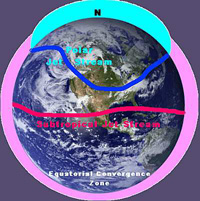Jet streams move toward the poles, the tropics broaden their reach, study says

Satellite measurements from 1979 to 2005 show that the atmosphere in the subtropical regions both north and south of the equator is heating up. As the atmosphere warms, it bulges out at the altitudes where the northern and southern jet streams slip past. That bulging has pushed both jet streams about 70 miles (113 kilometers) closer to the Earth's poles.
Since the jet streams mark the edge of the tropics, in essence framing the hot zone that hugs the equator, their outward movement has allowed the tropics to grow wider by a rough total of 140 miles (225 kilometers). That means the relatively drier subtropics likely have expanded as well, pushing closer to places like Salt Lake City, where Thomas Reichler, co-author of the new study, teaches meteorology.
The movement has allowed the subtropics to creep toward populated areas beyond just the American Southwest, such as southern Australia and the Mediterranean basin. In those places, the lack of precipitation already is a worry.
That could make climate change locally noticeable for more people, said Karen Rosenlof, a National Oceanic and Atmospheric Administration research meteorologist, who was not connected with the study.
"It is a plausible thing that could be happening and the people who are going to see its effects earliest are the ones who live closer to the tropics, like southern Australia," said Rosenlof, whose own work suggests the tropics have actually compressed since 2000, after growing wider over the previous 20 years.
Reichler suspects global warming is the root cause of the shift, but said he cannot be certain. Other possibilities include natural variability and destruction of the ozone layer. However, he and his colleagues have noted similar behavior in climate models, which suggests global warming plays a role, the AP reports.
Subscribe to Pravda.Ru Telegram channel, Facebook, RSS!

